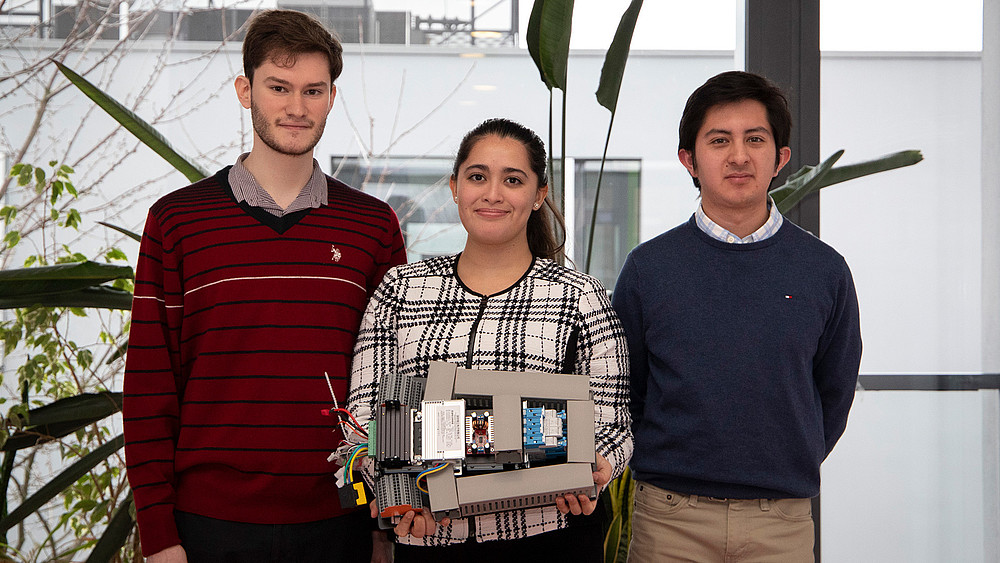Planning, constructing and designing a scooter from start to finish? With a 3D printed frame, environmentally friendly hydrogen drive and autonomous driving?

No problem for Fanny Mancilla, Luis Nava, Emilio Pizano, Jacob Mérida, Brenda San German and David Herrera, exchange students from the German-Mexican university "Instituto Tecnologico de Monterrey". They had one semester to produce their hydrogen scooter from the first sketches to the finished product.
The work had to be completed in two teams. While "Team Mechanics" dealt with "the development of design variants and the mechanical construction of a frame for the hydrogen scooter", "Team Electronics" was busy designing the motherboard and programming the autonomous driving system. The students were not in competition with each other, but on the contrary, one of the main focuses was on the close coordination of both areas in order to have constructed a fully functional scooter at the end. This was good preparation for working in regional to international companies, where increasing attention is being paid to teamwork and the ability to solve complex tasks with others when selecting employees. Added to this was the challenging mix of languages, juggling between Spanish, German and English.
The development of the scooter combines the application of future technologies with classic engineering disciplines, such as lightweight construction, additive manufacturing (3D printing), design, simulation and programming. The scooter also has the sensors and mechanisms for autonomous driving.
The highly complex task demanded a great deal from the students, starting with the classic literature research, project management including scheduling, through to the implementation of the project. The top priority in the design had to be the stability and safety of the user, of course, with many other variables to consider in addition to weight. But how do you create stability? Team Mechanik reports on the brilliant idea they came up with during their research: "Triangles are the basis of many bridge constructions; they ensure a high degree of stability and load-bearing capacity. They are the basic idea behind our design. We didn't want to design just any frame, we wanted to create something extraordinary."
Hydrogen drive on the roads?
Hardly any car manufacturer has not yet tried their hand at designing a production-ready car with this alternative fuel. But it's not the engineers at their desks who are in doubt about its usability, because the principle of generating electricity from hydrogen, which is then used for the electric drive, is well researched. The gaseous hydrogen is refueled and then reacts with air in the fuel cell to produce electrical energy. Only climate-neutral water vapor is blown out of the exhaust into the atmosphere.
Another problem is currently preventing the technology from making a breakthrough. For example, special high-pressure tanks and filling systems do not make the investment in a continuous network of filling stations lucrative for entrepreneurs.
Why did the supervisors from the university and the Fraunhofer Plastics Center Oberlausitz opt for this fuel? "The German government has set ambitious goals with its hydrogen strategy. The further development of this type of energy generation will be funded with two billion euros by 2025. The training of our students is very close to current developments," says Dr. Sebastian Schmidt from the Institute of Process Engineering, Process Automation and Measurement Technology (IPM). Together with Sven Meißner (Fraunhofer IWU) and Sebastian Reinicke (IPM), he supervised the students from Mexico.
Knowledge of alternative drive technologies and their application is also in great demand in the students' home country. Mexico City, the most populous metropolis in North America with 22 million inhabitants, has just set itself the goal of reducing greenhouse gas emissions by 30% over the next five years. The promotion of alternative energy sources to petrol and diesel is also part of the package of measures put forward by the mayor and climate researcher Claudia Sheinbaum.
The hydrogen scooter will be presented by the university and Fraunhofer for the first time at the Hannover Messe in April this year. The trade fair's motto "Home of Industrial Pioneers" could not be more fitting.
Text: Kristin Sprechert (Saxony5)
Your contact: Dipl.-Ing. Sven Meißner (IWU)
The HSZG is one of the 30 consortium universities of the Mexican-German University Cooperation (MDHK) as part of the German University Consortium for International Cooperation (DHIK). The Tecnológico de Monterrey is one of the largest universities in Mexico with over 25 campuses. Since the 2018 winter semester, students from Mexico have been coming to our university to complete a double degree in automation and mechatronics. Within one year, the students attend the courses, do an internship in a German company and then defend their Bachelor's thesis.
Students of the Faculty of Electrical Engineering/Computer Science - Automation and Mechatronics course - have the opportunity to take part in the Mexican-German University Cooperation program.
If you are interested, please contact Prof. Uwe Schmidt.
Further information on the program can be found here.